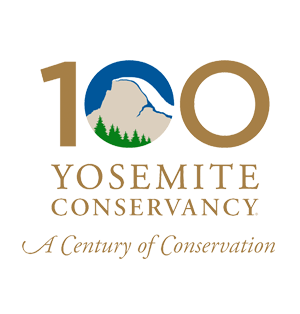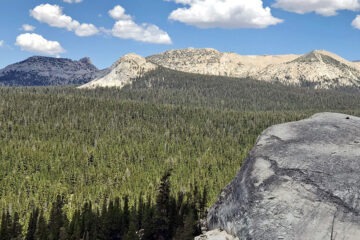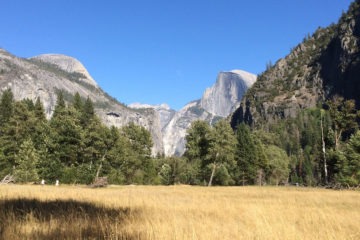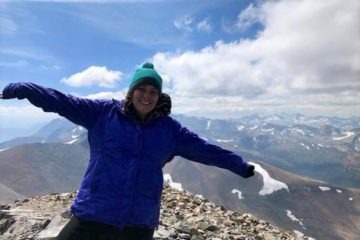Earlier this year, a group of naturalists gathered in Yosemite Valley to spend a spring day learning, hiking and planning together as they prepared for a busy season of leading Conservancy hikes, backpacking trips, birding expeditions, and more. Those naturalists have lived, worked and adventured all over the U.S. (and world), but all share a profound knowledge of, and love for, this 1,169 square-mile section of California. They bring expertise in Sierra Nevada geology, botany, biology, and natural and human history — and, perhaps most importantly, a passion for helping other people connect with this special place.
Our naturalists help people both experience Yosemite in a new way and give back to the park: Participation in our Outdoor and Custom Adventure programs supports trail restoration, research, youth programs and more. We hope you’ll join them for an adventure the next time you’re in Yosemite! In the meantime, enjoy this brief introduction to a few members of our naturalist team, who shared quick insights about their work (and play) in the park.
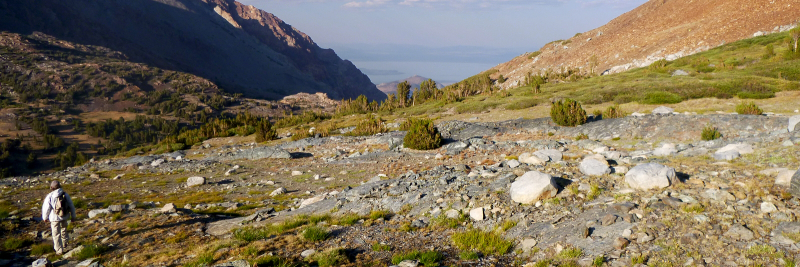
SUZANNE SWEDO has backpacked the mountains of every continent, authored numerous books (including Yosemite hiking guides), and shared her expertise in and enthusiasm for natural sciences, wilderness skills and the Sierra Nevada with Yosemite visitors for more than 30 years.
What’s your favorite place to take Yosemite visitors?
Mono Pass, where you can get a feel for the shape and the size and the age and the “big picture” of the whole Sierra Nevada. You can look west to granite that is younger than the metamorphic rock you’re standing on, and then look east over the crest to see how the whole range slopes gradually upward then abruptly drops away to the Owens Valley. I also love looking for superlatives: an entire willow less than 2 inches tall or a Townsend’s hare bigger than any bunny you ever imagined.
What do you enjoy doing in the park when you’re not leading adventures?
Writing about Yosemite. When I try to describe or explain some process or phenomenon to other people, I find that I have to pay closer attention to it myself, and almost always learn something new.
What’s the first word that comes to mind when you think of Yosemite?
Exhilaration!
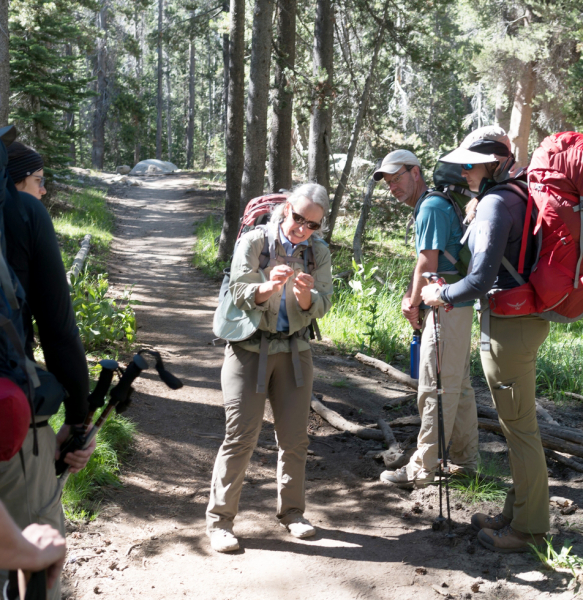 KARYN “KESTREL” O’HEARN began following birds around as an undergraduate studying environmental science at University of California, Santa Cruz in the 1990s. She has been an educator, trip leader and naturalist for numerous outdoor schools and organizations, and started working as a seasonal interpretive ranger-naturalist in Yosemite since 2002.
KARYN “KESTREL” O’HEARN began following birds around as an undergraduate studying environmental science at University of California, Santa Cruz in the 1990s. She has been an educator, trip leader and naturalist for numerous outdoor schools and organizations, and started working as a seasonal interpretive ranger-naturalist in Yosemite since 2002.
What’s your favorite place to take Yosemite visitors?
Lukens Lake is a top favorite among many special spots off the beaten path — it’s easy to get to and rich with Yosemite magic. Hodgdon Meadow also makes my heart joyful when introducing people to it. This spring I took my first group of visitors to Ackerson Meadow. Wow! Washburn Lake always delivers. There are more but my guests have sworn me to secrecy!
What do you enjoy doing in the park when you’re not leading adventures?
Fly-fishing, hiking to peaks, finding the less common flora described in An Illustrated Flora of Yosemite National Park, backpacking and birding. I’m always listening and looking for birds. Oh, and dipping in high-elevation lakes and streams.
What’s the first word that comes to mind when you think of Yosemite?
Glorious!
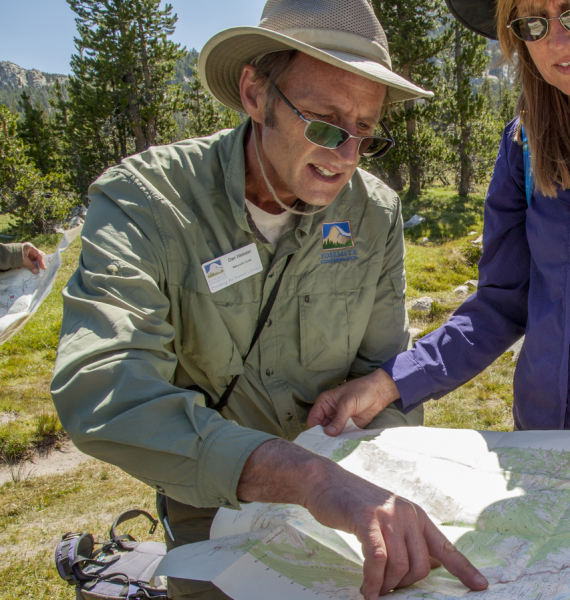 DAN WEBSTER got his start working in the wilderness as a forest firefighter, and spent more than two decades leading outdoor trips in western Maine. Today, he’s a Sierra Nevada-based naturalist, educator, birder and hiker who lives by his motto: “Any day in the mountains is a good day.”
DAN WEBSTER got his start working in the wilderness as a forest firefighter, and spent more than two decades leading outdoor trips in western Maine. Today, he’s a Sierra Nevada-based naturalist, educator, birder and hiker who lives by his motto: “Any day in the mountains is a good day.”
What’s your favorite place to take Yosemite visitors?
The Toulumne Meadows/Tioga Road region!
What do you enjoy doing in the park when you’re not leading adventures?
When not leading adventures, my favorite thing to do is pull off the road almost randomly and set off on mini trail-less adventures, always ready to sit down and make the acquaintance of new plant, bug and tree friends.
What’s the first word that comes to mind when you think of Yosemite?
Incomparable.
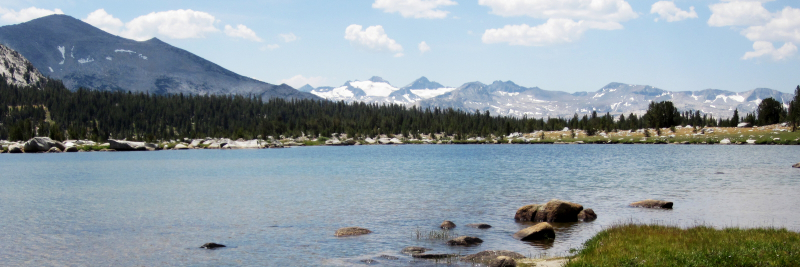
MARGARET GLOVER started her nature-focused career as a plant genetics researcher, but soon heeded her wanderlust and left the lab to travel, work and climb in Southeast Asia. Upon her return to the U.S., she made her way to Yosemite and joined the team at NatureBridge, an national environmental science nonprofit.
What’s your favorite place to take Yosemite visitors?
Gaylor Lakes
What do you enjoy doing in the park when you’re not leading adventures?
Rock-climbing! My favorite areas are Tioga Cliff (in the eastern Sierra, west of Lee Vining) and Fifi Buttress (just west of Leaning Tower, the rock formation adjacent to Bridalveil Fall).
What’s the first word that comes to mind when you think of Yosemite?
Rocks!
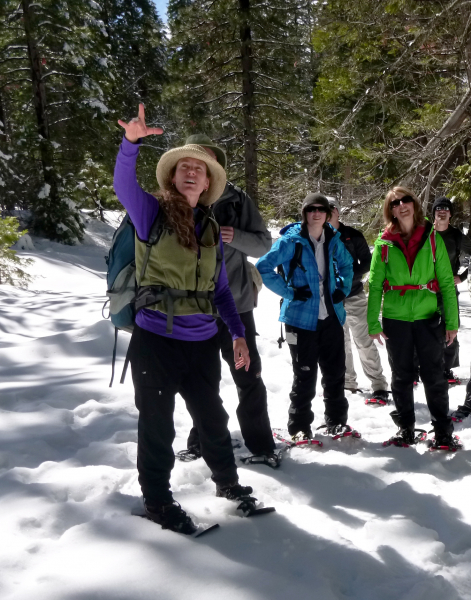
SHIRLEY SPENCER is a botanist, educator and artist who has lived and worked in Yosemite since 1979. In addition to being an expert naturalist, she is the author and illustrator of several books, including Living Among Giants: Botanical Treasures of a Sequoia Grove; a talented musician; and an accomplished adventurer.
What’s your favorite place to take Yosemite visitors?
Mariposa Grove, including Wawona Point
What do you enjoy doing in the park when you’re not leading adventures?
Hiking, botanizing, trail-running, watercolor painting, birding, swimming, stargazing, dreaming, and winter backcountry ice skating!
What’s the first word that comes to mind when you think of Yosemite?
Grandeur
KALEB GOFF grew up in San Diego County, and nurtured his passion for nature, science and conservation as a student at University of California, Santa Cruz. An avid birder and botanist, Kaleb has spent several years as a ranger-naturalist in Yosemite, where he seeks to connect people to nature through art and science.
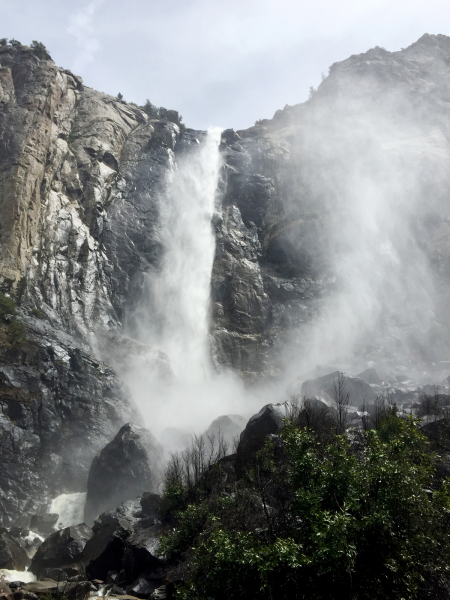 What’s your favorite place to take Yosemite visitors?
What’s your favorite place to take Yosemite visitors?
Lately, I’ve been enjoying taking visitors to the base of Bridalveil Fall. The base of the waterfall is always a wild and beautiful place. It is particularly special to me because it shows the wild, self-willed qualities that Yosemite Valley still holds, despite all of its human injunctions. This location is particularly incredible when the sun is just peeking over the Valley’s south rim or diving below the west end.
What do you enjoy doing in the park when you’re not leading adventures?
Being a naturalist is my passion to a degree that I often take off my Yosemite Conservancy hat, put on another and keep going! I really enjoy combining drawing and watercolor painting with my naturalist pursuits as a way of diving deep and re-creating my experiences of a place or creatures. I also enjoy climbing, mountain biking and swimming. What a deeply inspiring privilege it is to live and work in Yosemite!
What’s the first word that comes to mind when you think of Yosemite?
Home. Equilibrium. Wilderness. Hope.
ANDREA CANAPARY has lived in the Yosemite area for more than two decades, after falling in love with the park while leading backcountry California Conservation Corps (CCC) crews in the mid-1990s. She has spent much of her career as an outdoor educator, including 10 summers helping youth connect with wilderness in the Adirondacks, and has instructed at numerous environmental education centers in California and Oregon.
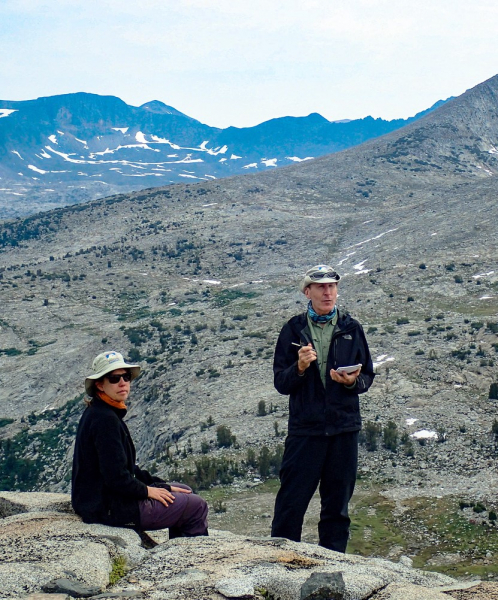 What’s your favorite place to take Yosemite visitors?
What’s your favorite place to take Yosemite visitors?
My favorite place to take park visitors really varies. It depends on the people, the weather, the time of year, where they are from, how much time they have in the park, their hiking ability, if they’ve ever been here before and so much more. I love to share the visitor’s excitement of a special place — that is what I enjoy about guiding, and where that place is matters less. The challenge and excitement of guiding for me lies in figuring out the perfect place for each unique situation within a few minutes of meeting the visitors. When I hit it right, that is my favorite place in that moment.
What do you enjoy doing in the park when you’re not leading adventures?
When I am not leading adventures, I enjoy exploring new places off-trail, and also slowing down and taking the time to notice and learn about birds, flowers, butterflies and more.
What’s the first word that comes to mind when you think of Yosemite?
Diverse.
PETE DEVINE is the Conservancy’s resident naturalist, the park’s first Leave No Trace Master Educator, and a longtime scholar of Lyell Glacier (as well as of other Yosemite features, flora and fauna). He has worked as a park ranger, river guide and archeologist; has traveled and led trips around the globe; and never ceases to be fascinated by his Sierra Nevada surroundings.
What’s your favorite place to take Yosemite visitors?
There’s NO unattractive or uninteresting part of Yosemite – you just can’t go wrong here. I especially appreciate getting to lead some our overnight wilderness treks; on those journeys, people have more time to relate to the beauties of our protected lands. Lyell Glacier, Half Dome and our Milky Way trips are among my favorites.
What do you enjoy doing in the park when you’re not leading adventures?
All of us naturalists are fortunate to genuinely enjoy just being out in Yosemite; work and play are similar in this way. My wife and I enjoy bicycling in and near the park — an activity that’s not often part of my work leading Conservancy adventures.
What’s the first word that comes to mind when you think of Yosemite?
“People!” At certain times and places the park’s 4-5 million annual visitors dominate Yosemite, but I also think of our predecessors here in the American-Indian people, Galen Clark, or Sally Dutcher (the sixth person to summit Half Dome). The fact that we get perhaps a million visitors from other countries is a marvelous testimony to how Yosemite and our park system inspire the world. We also have Frederick Law Olmsted’s 1865 vision to keep us focused on the need to protect this park for the people of the future.
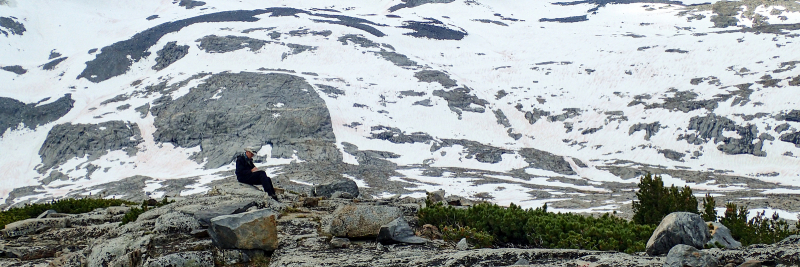
Get to know some of our naturalists a little more here on the blog, where you’ll find Pete’s insights on winter birds, autumn light and trail stewardship; Kaleb’s tips on tracking wildlife (and a wild life); and more.
And when you’re ready to start planning your next Yosemite adventure, consider spending some time with our naturalists. No matter where they lead you — Mono Pass, Lukens Lake, the base of Bridalveil Fall — or what you do — explore less-traveled trails, enjoy summit views, inhale the vanilla scent of Jeffrey pines, examine the delicate details of flower petals and bird wings — we guarantee you’ll feel a deeper connection with the world around you.
